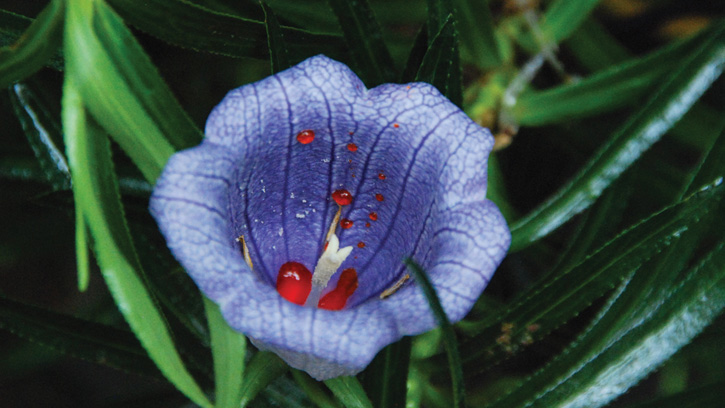A Natural Red Blossoms
Science Forward | RESEARCH
The infamous Red Dye No. 2 panic in the 1970s helped fuel an ongoing quest for stable natural red food colorings. Now, researchers are reporting that a newly discovered compound found in the nectar of two extremely rare flowers could become a valuable addition to the natural reds stable.
Vividly hued nectars themselves are rare: Only about 70 flowering plants have colored nectars, says Adrian Hegeman, professor at the College of Food, Agricultural and Natural Resource Sciences at the University of Minnesota and part of the team researching colored nectars.
“Somebody had mentioned this plant [Nesocodon mauritianus from Mauritius] in the conservatory on campus and had noted that it had this sort of blood red–colored nectar, which is really unusual for plant nectars,” says Hegeman.
When the flower of N. mauritianus is developing and begins to open, the nectar starts out as yellow, changes to orange, and then turns red as the anther and the pollen ripen, explains Hegeman. The researchers used a mass spectrometer to analyze a sample from the university’s N. mauritianus plant and found that the nectar’s color compound was previously unidentified; they discovered a new alkaloid, nesocodin, which is responsible for the red pigment. The researchers then examined nectar from the related Jaltomata herrerae plant as a comparison and determined that this red-nectared flower also contains nesocodin.
“We knew right away that this was something completely different from what we were expecting, and there aren’t a lot of red alkaloids out there,” Hegeman says. The team’s research was recently published in Proceedings of the National Academy of Sciences, and the researchers have received a $1.3 million grant from the National Science Foundation (NSF) to continue their work with colored nectars.
Colored nectars usually are pollinated by vertebrates, such as the day gecko that is believed to pollinate N. mauritianus. When the nectar is colored, it’s possible that the animal can see from a distance if the flower has any nectar that will make the trip to get it worth the energy—what ecologists call an honest reward signal. “There might be some advantage to the flower to be able to advertise that yes, I’ve got a reward for you here,” says Hegeman.
Better Stability
Many of the natural red pigments currently in use, such as anthocyanins, have terrible stability because they are easily oxidized and are sensitive to pH levels, says Hegeman. After the pH rises higher than about 8, they lose their red and change into what Hegeman describes as a “yucky greenish color.”
“For any natural color, there’s going to be a suite of reactivities and conditions where it’s stable or maintains its color,” he says.
The researchers are excited about the red from nectar in the two rare plants because it appears to stabilize in the 8 to 10 pH range, which means it’s much more stable than some other natural colorants. It also has less of a “yuck factor” than food colorants like carmine, which is derived from cochineal insects, says Hegeman. “People might actually appreciate it as something coming from nectar, which is more appealing,” he observes.
The NSF grant will enable researchers to perform further work in important areas like nectar toxicology. They have been assuming the nectar’s red color compound isn’t toxic to humans simply because it doesn’t seem to be poisonous to geckos or hummingbirds, the latter of which is particularly sensitive to toxicity, says Hegeman.
The University of Minnesota has applied for a patent for synthesis of the compound, but even at this early stage, there’s been a lot of interest in the findings because it’s a natural colorant, says Hegeman. And red may just be the beginning for colored nectars: The researchers are looking into plants “that have pretty amazing ranges of colors,” says Hegeman, including yellows, rusts, blues, greens, and one that is almost a charcoal black.
“It’s clear there’s this really interesting place to explore in nectar,” says Hegeman, “especially when you see the creation of the coloration that’s involved in signaling events between pollinator and plant.”


